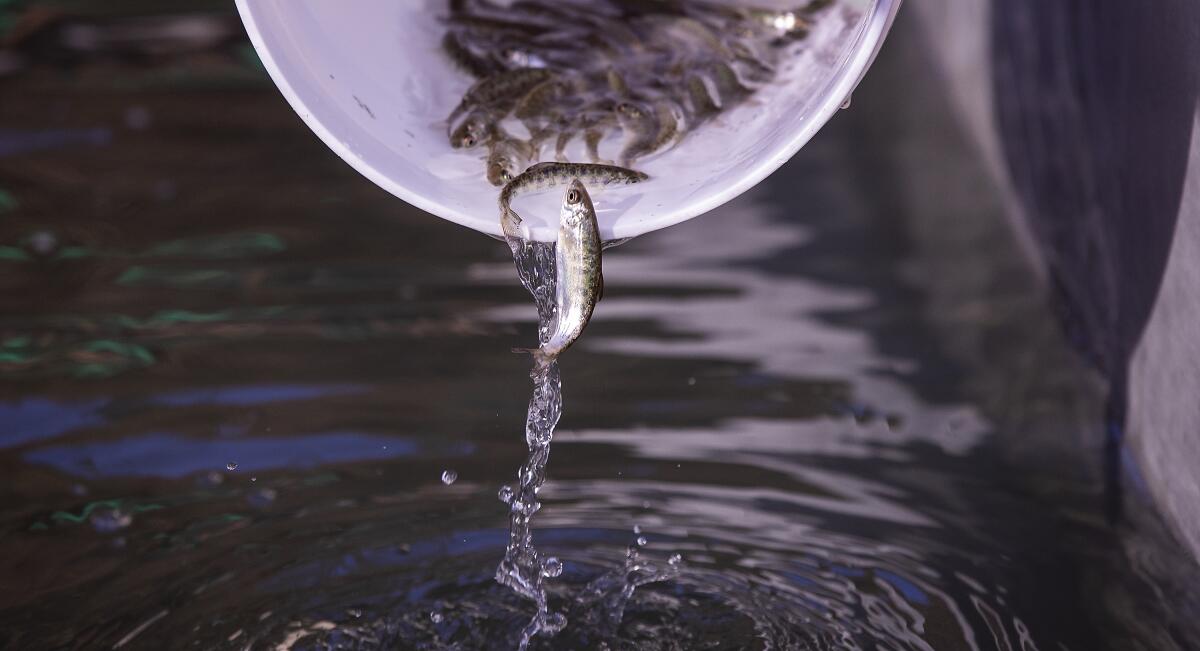Column: Newsom cares more about almond growers than California’s salmon fishery

- Share via
SACRAMENTO — Gov. Gavin Newsom bills himself as a protector of wildlife, so you wouldn’t think he’d take water from baby salmon and give it to almonds.
Or to pistachios, or cotton or alfalfa.
Especially when California was just drenched with the wettest three-week series of storms on record and was headed into another powerful soaking of snow and rain.
But Newsom and his water officials still contend we’re suffering a drought — apparently it’s a never-ending drought. So, they used that as a reason last week to drastically cut river flows needed by migrating little salmon in case the water is needed to irrigate San Joaquin Valley crops in summer.
Still calling our wet weather a drought is a shameful distortion of a word — a propaganda device aimed at convincing people they should keep conserving water. People should, but they don’t need to be talked to like they’re children.
What Newsom and government officials are really talking about is a long-term water shortage. It’s caused by California having more agriculture and people than can be sustained with what nature provides us. And it’s made more problematic by the uncertain prospects of climate change.
But a water shortage doesn’t necessarily mean drought. It means we’re not recycling, conserving and recharging aquifers enough — and not judiciously allocating what we’ve got.
Agriculture uses 80% of California’s developed water. The rest is allocated to domestic use — business and residential.
Calculated another way, 40% of all water — developed or not — winds up with agriculture and 10% goes to domestic use. The remaining 50% goes directly into the environment — running down streams, watering what’s left of our wetlands and flowing into the ocean. And en route to the ocean, river flows carry baby salmon out to sea, where they grow up.
The Sacramento River is the second-biggest producer of salmon on the West Coast, behind only the Columbia.
But salmon numbers have been plummeting on the Sacramento in recent decades, largely because of dams that block historic spawning areas and the diversion of water to farms and cities.
Also, plumbing in the Sacramento-San Joaquin River Delta screws up salmon. Giant pumps that send water south through aqueducts mangle the critters or draw them into the grasp of lurking predators.
There are four salmon spawning runs up the Sacramento and San Joaquin rivers each year. By far the largest is in the Sacramento. The most significant is in fall. Last fall, fewer than 62,000 fish returned to spawn, the second lowest in 70 years. The fall before, there were nearly 132,000.
Those are steep drops from 448,000 in 2013 and 873,000 in 2002.
Meanwhile, almonds — one of our thirstiest crops — are proliferating. We’re up to 1.6 million acres’ worth, mostly in the San Joaquin Valley. California produces 80% of the world’s almonds. Roughly two-thirds are exported.
“Salmon numbers have fallen significantly every Newsom year — one-third since he became governor,” says Barry Nelson, a longtime water consultant and environmentalist.
But should Newsom be blamed for that? We’ve been in a real drought.
“Absolutely,” Nelson says. “Without a doubt the governor is responsible. He’s been waiving standards designed to protect salmon. The failure of the state to protect salmon has turned bad news into a disaster.”
“In the same four years that salmon have crashed,” Nelson adds, “almond acreage has expanded by 320,000 acres.”
Newsom on Feb. 13 signed an executive order allowing the suspension of salmon protections. It was as if we were still suffering from drought and every drop of water was needed for humans and food production.
“To protect public health and safety, it is critical the state take certain immediate actions without undue delay to prepare for and mitigate the effects of the drought conditions,” the governor proclaimed in his order.
The state Water Resources Control Board, which the governor appoints, dutifully obliged and suspended a requirement for flows through the delta estuary that salmon need this time of year to push them out into the ocean.
The suspension basically cut flows in half until at least late March. The water will be stored in reservoirs.
But the big reservoirs already were refilling from January storms. And the Sierra snowpack was deep — at 173% of normal for last week.
“It’s not even a drought. If we can’t provide good conditions for fish in a year like this, then we are totally bankrupt as resource managers,” says Gary Bobker, program director at the Bay Institute, an environmental organization that focuses on San Francisco Bay.
Young salmon — roughly 4 inches long — need strong river flows to carry them through the delta, into San Francisco Bay and out the Golden Gate.
“They’re poor swimmers,” says John McManus, president of the Golden State Salmon Assn. “They evolved to be washed down rivers in spring as nature would. But that’s been turned on its head. Now the water is released in summer for agriculture.”
That’s because agriculture has more political clout.
McManus says the governor “doesn’t return our calls or respond to our emails.”
“The single biggest problem for salmon in California is the lack of springtime flow in rivers,” McManus asserts.
Maybe 1% are making it to the ocean.
Eric Oppenheimer, the water board’s chief deputy director, told me: “We’re not saying [the flow reduction] won’t have any effect” on fish. “We’re just saying we don’t think the change will result in an unreasonable impact.”
The state Department of Fish and Wildlife basically agrees.
“At this point, we’re still in a drought,” Oppenheimer said. “We’re sometimes in a drought and flood simultaneously.”
That doesn’t make sense to me.
Neither does cutting back water for struggling baby salmon when it’s pouring rain.
More to Read
Sign up for Essential California
The most important California stories and recommendations in your inbox every morning.
You may occasionally receive promotional content from the Los Angeles Times.










